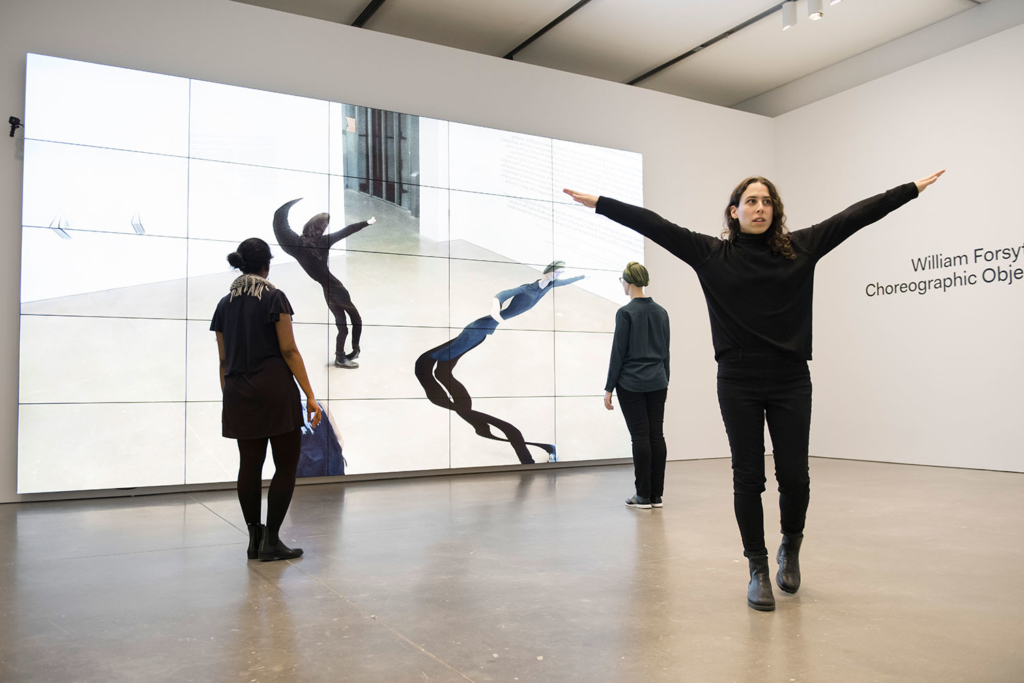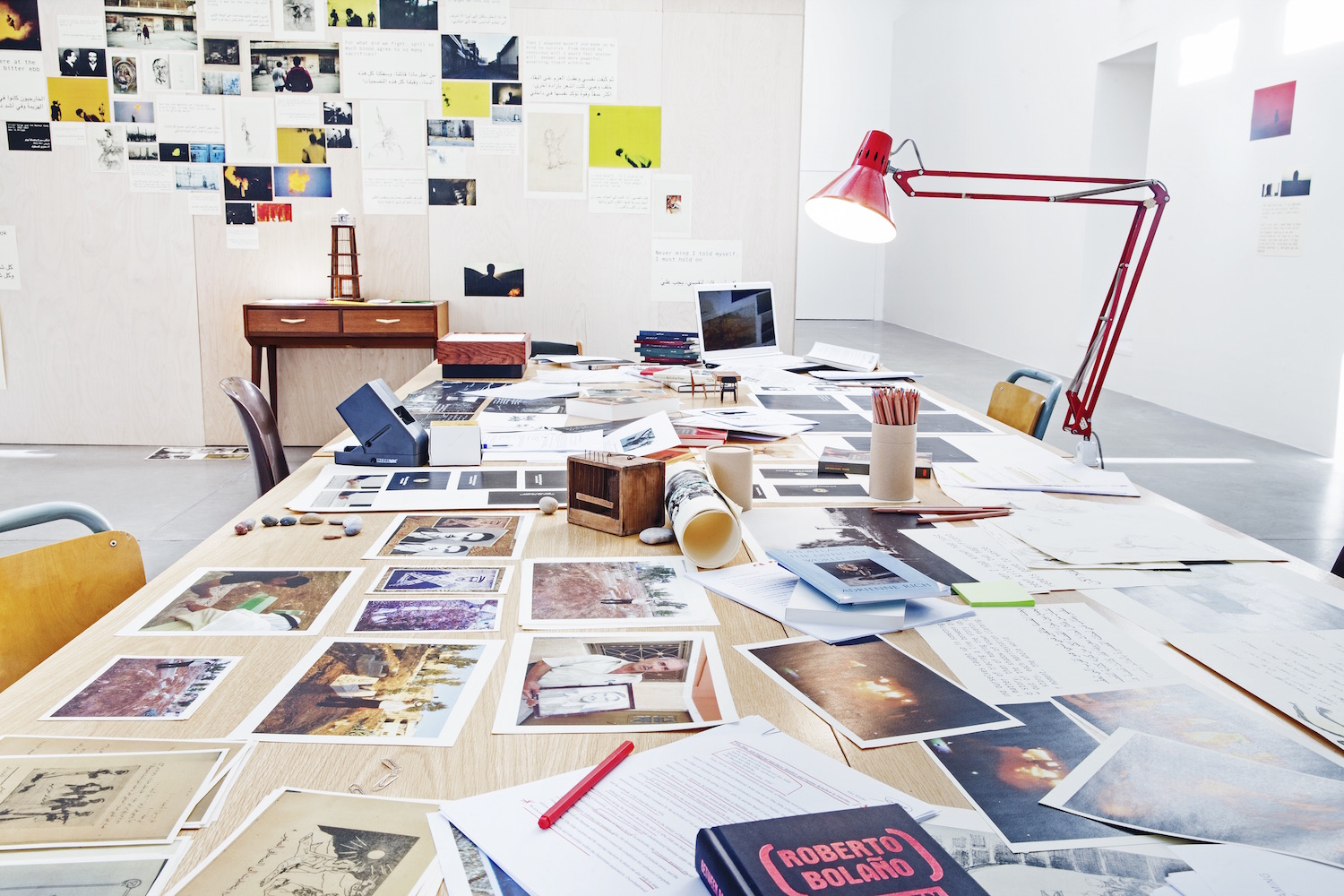Dance Office is a column dedicated to contemporary dance and performance art.

It’s fitting that American dancer, choreographer, and artist William Forsythe — one of the most prolific choreographers of all time, who brought American ballet sensibilities to Europe and uses math, philosophy, and architecture to inform his dances — has chosen to fundamentally question the doctrine of the medium in which he has made his career. In a series of site-specific, interactive exhibitions titled “Choreographic Objects,” on display at the Institute of Contemporary Art (ICA), Boston, through February 21, 2019, Forsythe has sought to model physical thinking on objects instead of bodies.
Each installation within the exhibition seeks to answer the question: “What else, besides the body, could physical thinking look like?” The “objects,” each of which expands the notion of choreography, and qualifies dance and choreography as two distinct practices, can be divided into three general categories: large interactive installations, smaller-scale tactile sculptures, and video. Each section is united in that they collectively facilitate movement by the spectator, and invite interrogation of the physical, social, and intellectual executions of the body — by imposing choreography on objects in lieu of dancers. Put simply, Forsythe says, “With choreography, the audience sits still and ideas are moved in front of them,” whereas, in an installation setting, “the audience circulates among the ideas.”

It might seem counterintuitive for a series of works about movement to be archived in a book published on the occasion of the exhibition, but the catalogue captures one of Forsythe’s most prominent themes: the democratization of choreography, and the assertion that it is possible everywhere: shifting the process of choreographic thinking from the trained dancer to the civilian, and from the stage to the gallery or museum. By placing untrained bodies in a constructed environment, Forsythe creates spaces in which intellectual curiosity is carried out through the body — the best version of what dancing can feel like. “I feel the project of the democratic dance is perhaps almost impossible to achieve within a theater,” he said. “It seems that only by ambushing amateurs can you arrive at a truly democratic way of organizing dance.”
His use of “ambush” is apt here: Forsythe’s sculptures encourage a quiet contemplation of mortality and physical limitation (possibly the most democratizing principles). When one is ambushed by confronting his objects, one is ambushed by their own body.
Having danced some of Forsythe’s ballet choreography when I was young, the democratization of dance strikes me as a delightfully paradoxical ideal for him to embark upon. His choreography places enormous demands on dancers, and his interest in choreographing seems to lie in complex organizational systems, replacing the usual story-content of ballets with rigorous structure. The result is choreography that speaks to a larger investigation into what choreography is — to dance the work is to investigate the underlying logic that informs it. Especially challenging are Forsythe’s reconfigurations, like the reversal of épaulement (a tenant of ballet that requires an unceasing connection between the hand, foot, hip, and head) that is second nature to the classically trained dancer.
This kind of choreography can, of course, be restricting for dancers or audience members seeking proper balletic form, but in its best iterations, Forsythe’s more candid movements, often divorced from familiar, concrete character motivations, foster the communication of a more universal kind of interaction with an environment. While some have argued that this kind of dancing is an attack on classical ballet, Forsythe has done more than any other contemporary choreographer to demand that ballet grapple with the same aesthetic concepts as the rest of contemporary art.

In a 2013 “Choreographic Objects” presentation titled Nowhere and Everywhere at the Same Time No. 2, shown at the Grande Halle de la Villette, a former slaughterhouse in Paris, Forsythe modeled this kind of choreographic disorientation for the casual viewer. In the show, electronic music by Ryoji Ikeda played while spectators moved through hundreds of Forsythe’s pendulums, swinging to different rhythms. By creating objects that act as surrogates for real-life interactions with the environment, Forsythe challenged the viewer to consider latent sensations and phenomena. Forsythe explains: “The pendulums are a perfect example of translation from stage work to choreographic object. I’m not asking the museum-going public to develop the facility of moving with intention around an imaginary form — it’s too difficult. But if I provide an actual object, what does it say about the quotidian encounters with that phenomenon, which we actually experience all the time?”
I first viewed a “Choreographic Objects” exhibition in person last year at Gagosian Le Bourget, a former airplane hanger-turned-gallery in the northeastern suburbs of Paris. I had broken my toe in an especially un-terpsichorean moment of clumsiness, and was optimistic that Forsythe, refreshing his utter rejection of the mind-body dualism (crazy ballerina) trope, might provide an expression of movement outside the context of a body, as I needed a reprieve from thinking about my own. The work, Black Flags, confirmed Forsythe’s assertion that choreography can happen anywhere, anytime. It featured poles with ominous black flags held up by identical black robots, who swept and twirled the poles around, bringing to mind Loïe Fuller’s skirt dances. The flags seemed somehow musical, interacting only with air but filling the room. When discussing Black Flags, Forsythe has said that the robots act as “poetic instruments of writing,” and the space creates room for “choreographic writing.” In one of the book’s featured essays, art writer and professor Molly Nesbit unexpectedly connects the Black Flags with Artaud’s Theatre of Cruelty, and offers a paradigm by which the flags could be associated with an existential state instead of a nationalist or ideological one:
When flown (black flags) have come with connotations of piracy, anarchy, jihadism, fascism, and insect death. Forsythe’s Black Flags belong to this species of disorder and doom. Theirs is a theater of difference, insurrection, rising power, and sadism, if it is anything we can use language to name. In deeds, not words, they proclaim a collective condition. We might call it a new theater of cruelty.

The book Choreographic Objects, focusing on the series of exhibitions, certainly should not serve as a primer to Forsythe as an artist overall, but does covers an impressive array of his work. It includes a survey of Forsythe Company (which he directed from 2005 to 2015) repertoire, stills from his CD-ROM Improvisation Technologies, which explores the geometric forms of ballet, and an essay by choreographer and scholar Susan Leigh Foster on his open-access digital platform for dance notation and analysis, Synchronous Objects for “One Flat Thing, reproduced” (2009). The photos of the “Choreographic Objects” themselves are charming, and show people playfully exploring the work.
Enthusiasts of Forsythe’s ballet productions will be pleased that he does not seem to have lost interest in the stage: “A Quiet Evening of Dance,” which he describes as a “distillation of the geometric origins of classical ballet,” enjoyed a successful run in London last month, and he will premiere a new work at the Boston Ballet in March 2019, and New York City Ballet’s winter season will feature the return of his Herman Schmerman, an eccentric full-length ballet with an electronic score. To limit himself to bodies or objects would be uncharacteristic, but perhaps the division between the two as concept-models is superficially constructed. As Forsythe is quoted in one of the book’s essays, “A life in a body is a life of negotiating the real world. I derived these principles from ballet, which puts the body in a precarious situation, and applied them elsewhere. Ballet is often presumed as a stable and noble practice, but its value lies precisely in its constant state of destabilization and precarity. All the ideas in my work are native to the practice. I’ve just found other instances.”


